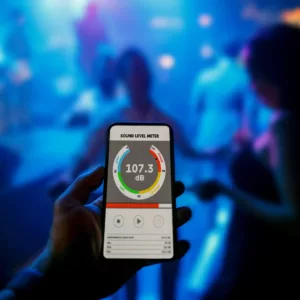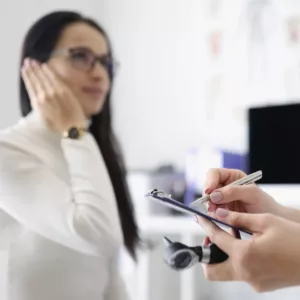Hearing Loss in Millennials and Gen Z: Causes, Symptoms, and Solutions
Hearing Loss Isn’t Just An Issue for Your Grandparents
Contrary to popular belief, hearing loss is not exclusive to older people. A new trend is emerging: hearing loss in millennials and Gen Z is growing, challenging the age-old stereotype of hearing loss. Recent studies have painted a concerning picture, revealing that around 10% of millennials and 17% of Gen Z suffer from some form of hearing loss. This trend signifies a crucial shift in our understanding of hearing health, underscoring that it concerns all ages.
The causes of millennial hearing loss and Gen Z hearing loss are multifaceted. Today’s world bombards millennials and Gen Z with unprecedented noise levels, from constant headphone usage to exposure to loud environments like concerts and nightclubs. This has led to a noticeable uptick in hearing loss cases among these groups. Furthermore, certain medications, known as ototoxic, contribute to this trend. The impact of hearing loss on millennials and Gen Z extends beyond mere statistics. It affects daily communication, strains relationships, and poses challenges in academic and professional settings. Misconceptions surrounding hearing loss further exacerbate the problem, as many young people remain unaware of the risks or the subtle onset of this condition. As a result, they often overlook the early symptoms, delaying necessary intervention and care.
Unveiling the Causes: Millennial and Gen Z Hearing Loss Demystified
In today’s digital era, millennials and Gen Z face unique challenges contributing to hearing loss. One significant factor is the advanced public sound amplification technology. Concerts and public events now use systems capable of producing deafening sounds, far exceeding what previous generations experienced. Additionally, the affordability and prevalence of these technologies mean they are more common in various public spaces, from city streets to personal vehicles, often producing damaging sound levels.
Moreover, the shift to online streaming media has drastically increased the duration and intensity of headphone use among young people. Continuous exposure to loud sounds through earbuds and headphones, often unnoticed by adults, is a significant concern. This change in listening habits, coupled with the direct delivery of sound into the ear canal, poses a greater risk than ever before.

Noise-induced Hearing Loss and Its Impact on Gen Z and Millennial Hearing Loss
Noise-induced hearing loss (NIHL) is a growing issue among millennials and Gen Z. The human ear can typically withstand sounds below 85 decibels (dBA) without damage. However, regular exposure to higher decibel levels can lead to permanent hearing loss. This risk increases as the sound intensity rises, with headphones connected to personal listening devices often reaching 110 dBA. The Centers for Disease Control and Prevention (CDC) reports that 40 million people aged 20 to 69 have hearing damage from everyday noise exposure.
The repercussions of such exposure are profound. Initially, it may lead to communication difficulties, affecting relationships, workplace success, and overall well-being. Untreated hearing loss can result in lowered self-esteem, social isolation, and even cognitive decline, increasing the risk of dementia in later life.
Those who grew up in the internet and digital technology age are particularly vulnerable to hearing loss, particularly millennials and Gen Z. The World Health Organization (WHO) estimates that 1.1 billion young people are at risk of hearing loss due to noise exposure. This exposure comes from headphones, louder entertainment venues, and the constant noise of urban environments.
Understanding the risks and the need for safe listening practices is essential for preserving hearing health. While the hearing damage can be gradual and subtle, its long-term effects impact every aspect of life, from personal relationships to professional success. By addressing these risks head-on, millennials and Gen Z can take proactive steps to protect their hearing and ensure a healthier, more connected future.
Discover more about hearing safety tips.
Other Factors Contributing to Hearing Loss in Millennials and Gen Z
In addition to noise exposure, ototoxic medications play a significant role in the hearing health of millennials and Gen Z. Ototoxicity refers to drug-induced damage to the inner ear, leading to hearing loss, tinnitus (ringing in the ears), or balance disorders. This category includes a range of medications, such as certain antibiotics (like aminoglycosides and macrolides), pain relievers (like high-dose aspirin), chemotherapy drugs (such as cisplatin and carboplatin), and some diuretics. It’s important to discuss potential hearing risks with healthcare providers before starting any new medication, especially for those already at risk for hearing loss.
Aside from ototoxic medications, various medical conditions and lifestyle factors contribute to hearing loss in younger generations. Conditions like Meniere’s disease, an inner ear disorder, and otosclerosis, a bone growth issue in the ear, can lead to hearing impairment. Head injuries, ear infections, and meninges (brain membranes) infections can also adversely affect hearing. Moreover, genetic predispositions to hearing loss play a role, though these are less common.
These various factors highlight the complexity of hearing loss in millennials and Gen Z. It’s not just about turning down the music or avoiding loud events; it’s about a comprehensive approach to hearing health.
Understand the Symptoms: Recognizing the Early Signs of Hearing Loss
Hearing loss is becoming a significant concern for younger generations, including millennials and Gen Z. Unlike the gradual hearing decline typically seen in older adults, hearing loss in these younger groups can be less noticeable but equally impactful. Recognizing the early signs is critical to preventing further damage and seeking timely help.
Common Symptoms of Hearing Loss in Millennials and Gen Z
- Difficulty in Noisy Environments: One of the first signs is struggling to hear in crowded or noisy settings, such as parties or restaurants. If you repeatedly ask others to repeat themselves, it might be an early indication of hearing loss.
- Challenges with High-Pitched Sounds: Difficulty in catching high-pitched sounds, like children’s voices or birds chirping, can be a subtle warning. You might miss parts of conversations or fail to appreciate the nuances in music.
- Increasing Volume on Devices: If you’re turning up the TV, music, or phone volume more than usual because things sound muffled or unclear, it’s time to assess your hearing.
- Experiencing Tinnitus: Tinnitus, characterized by ringing or buzzing in the ears, can be a temporary or persistent sign of hearing damage.
- Social Withdrawal: Avoiding social situations due to difficulty following conversations is a typical response to undiagnosed hearing loss. It may lead to feeling left out or disconnected from others.
Subtle Behavioral Changes Indicating Hearing Loss in Millennials and Gen Z
- Seeming Distracted in Conversations: If you find yourself frequently lost or frustrated during discussions, it could be due to hearing difficulties.
- Altered Phone Use: Holding the phone away from your ear or relying on a speakerphone for more unmistakable sounds can indicate hearing issues.
- Volume Adjustments: Regularly changing the volume on various devices can be a sign that you’re compensating for decreased hearing ability.
- Need for Clarification: If you’re increasingly asking for things to be repeated or clarified, it could be a symptom of hearing loss.
The American Speech-Language-Hearing Association (ASHA) emphasizes that these symptoms are key indicators of hearing impairment. While each person experiences hearing loss differently, these symptoms are common red flags. Recognizing and addressing these early signs in millennials and Gen Z is essential for maintaining hearing health and overall quality of life.

The First Solution is Prevention
Millennials and Gen Z are known for their vibrant, fast-paced lifestyles, often accompanied by a soundtrack of music, videos, and digital media. While this adds an exciting rhythm to life, it’s crucial to remember the importance of protecting our hearing. Here are effective ways for younger generations to safeguard their auditory health.
Smart Listening Practices:
- Volume Control: The 60-60 rule is a game-changer – listen at no more than 60% of your device’s maximum volume for 60 minutes at a time. This simple practice can significantly reduce the risk of noise-induced hearing loss.
- Noise-Canceling Headphones: Invest in these modern marvels. They allow you to enjoy your music at lower volumes, reducing the strain on your ears even in noisy environments.
- Earplug Essentials: Always have earplugs handy for unexpectedly loud settings. They are discreet and effective and can dramatically lower noise levels to safer decibels.
- Mindful Monitoring: If you use headphones, ensure they do not exceed 50-60% volume. For young kids, over-the-ear headphones are a safer choice compared to earbuds.
Creating a Hearing-Friendly Environment:
- Regular Noise Breaks: Balance your day with quiet moments. Regular breaks from headphones and noisy environments give your ears a much-needed rest.
- Protective Gear in Noisy Workplaces:** If you work in a loud environment, ensure you’re using earmuffs or other protective gear. It’s not just a personal preference; it’s a health necessity.
- Sound Sleep Practices: Avoid sleeping with headphones on. Instead, opt for a quiet environment or use an eye mask and soothing sleep sounds. This practice prevents potential hearing damage and promotes better sleep quality.
Promoting Overall Ear Health:
- Healthy Diet: A diet rich in antioxidants, vitamins B12, and folate supports ear health. Incorporate fruits, vegetables, and whole grains into your meals to nourish your auditory system.
- Regular Exercise: Exercise isn’t just good for your body; it benefits your ears too! Improved blood circulation from physical activity helps maintain healthy hearing.
- Stress Management: High stress levels can impact your hearing. Engage in relaxation techniques like yoga or meditation to manage stress effectively.
Learn more about supplements for hearing health.
Proactive Measures for Long-Term Hearing Health:
- Annual Hearing Tests: Don’t overlook the importance of regular hearing check-ups. Early detection of any issues is crucial for effective management and prevention of further damage.
- Family History Awareness: If hearing loss is common in your family, be extra cautious. Get your hearing tested more frequently and stay alert for any signs of hearing issues.
- Spread Awareness: Educate your friends and family about the importance of hearing health. Sharing these tips can help create a community that values and protects its hearing.
Remember, your hearing is a precious asset. By adopting these preventive strategies, millennials and Gen Z can ensure that the soundtrack of their lives remains clear and vibrant for years to come. So turn up the awareness, not just the volume, and cherish the beautiful sounds of life.
Spotlight on Solutions for Hearing Loss in Millennials and Gen Z
If you or someone you know is experiencing symptoms of hearing loss, it’s time to take action. Here’s how millennials and Gen Z can tackle this challenge head-on.
Steps to Take for Better Hearing Health:
- Schedule a Hearing Test: The first step in addressing hearing concerns is to get tested by an audiologist. They can provide a thorough assessment and identify any issues.
- Consult with Your Doctor: Discuss any hearing concerns with your healthcare provider. They can rule out or treat underlying medical conditions contributing to hearing loss.
- Adopt Protective Measures: Minimize your exposure to loud noises. Use ear protection in noisy environments and keep the volume at safe levels when using headphones or listening to music.
- Explore Treatment Options: If you have hearing loss, explore available treatments with your audiologist. Modern solutions like hearing aids and assistive listening devices fit seamlessly into your lifestyle.
Modern Hearing Solutions: Technology Meets Style
Forget the outdated image of bulky hearing aids. Today’s hearing solutions for millennials and Gen Z are as stylish and technologically advanced as the latest gadgets. These devices are not just about hearing better—they’re about integrating seamlessly into a digitally connected lifestyle.
Innovations in Hearing Aids:
- Style and Discretion: Modern hearing aids come in discreet designs, from nearly invisible in-ear models to stylish behind-the-ear options. They can either make a fashion statement or blend in unnoticed.
- Wireless Connectivity: Many hearing aids now function like Bluetooth headsets, connecting wirelessly to smartphones, TVs, and computers. This feature allows users to receive sound directly in their ears, enhancing clarity and convenience.
- Customizable Settings: With adjustable frequencies, noise cancellation, and personalized settings, today’s hearing aids meet individual preferences and needs, ensuring optimal sound quality in various environments.
- Apps for Personalization: An array of apps are available for hearing aid control,
- tinnitus management, and hearing health tracking. These apps offer personalized sound experiences and connect users to a community of others managing hearing loss.
- Smart Home Integration: Modern hearing aids can sync with smart home devices, allowing users to adjust settings like thermostats or stream music directly to their ears. This integration represents a leap forward in creating a seamless auditory experience.
- Enhanced Speech Clarity: Advanced hearing aids deliver increased clarity in conversations, even in noisy settings. They can amplify soft speech and help distinguish where sounds are coming from, improving spatial orientation.
- Focused Listening: These devices allow users to prioritize important sounds or conversations and adjust settings for different environments, all controllable via a smartphone or smartwatch.
Hearing Aids Today
Especially for students, young professionals, or active adults experiencing hearing loss, the latest generation of Bluetooth hearing aids can be a game-changer. These devices empower users to fully engage in their daily lives without missing a beat. If you’re experiencing hearing loss, consulting with an audiologist about these advanced options is a step toward reclaiming the full richness of sound in your life. Remember, embracing these solutions is not just about hearing better—it’s about enhancing your overall quality of life.
Find out more about the latest hearing loss research.

Handle Your Hearing Loss By Being Proactive
As we’ve explored throughout this article, hearing loss in millennials and Gen Z is a growing concern that demands attention and action. From the bustling soundscapes of daily life to the risks posed by noise exposure and ototoxic medications, it’s clear that our hearing health is under more strain than ever before. But the news is manageable. Younger generations can effectively manage and protect their hearing with the right knowledge and tools.
Remember, hearing loss doesn’t have to be an inevitable part of your story. With the proper care and action, you can enjoy the symphony of sounds life offers at every stage. So don’t hesitate – reach out to us today and take the first step towards a future of clear, vibrant hearing. Contact American Hearing + Audiology for an appointment at one of our top-rated hearing centers.






